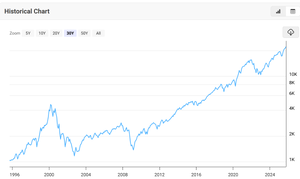-
Posts
8,038 -
Joined
-
Last visited
-
Days Won
64
Content Type
Profiles
Forums
Gallery
Downloads
Blogs
Events
Our Shop
Movies
Everything posted by Jerry_Atrick
-
A member of me team recently returned from the US - Portland, WA. In his observation, the average American doesn't really know or care what is going on in the Whitehouse; with their government. It is a bit like most people everywhere. People just go about their daily lives; they vote and then they wait for the next election to vote.. that is their participation in democracy. Unless something directly affects them, they see the news, and go about their daily life. The news they see is 1/2 hour a day in the evening, like most people; they see their social media channels, more revolving around lifestyle or interests than politics. Which is why Chump is a product of society. Execs are not kowtowing to Chump.. they are doing what they are paid to do.. get the best value for their shareholders. If it would cost them more to kowtow to Chump, they wouldn't. Kier Starmer slupring up Chump's posterior so much, his nose was poking outside Chump's mouth showed how utterly powerless the UK has been. But it is also symptomatic of how spineless the west has become. At school and at home, we are taught to stand up to bullies, otherwise they will just keep doing it. But for some reason, as a collective society, we seem to have lost our spine to stand up to bullies, accept it is going to hurt, but know in the long run it will be less pain - because the bully will continue otherwise. We have seen it play out with Russia and we are seeing it play out with Chump. The unprecedented second state visit to a royal family who are probably less receptive to Chump and his cohorts than they were to Gadaffi - as an attempt to placate the bully and curry flavour - simply has emboldned him, and after showing the UK as a gutless bunch of arse lickers has achieved no relative benefit. Tariffs are the same as they are for most countries, Chump and his cohorts -0 including Farage - continue to belittle the UK (and other countries), and their coercive efforts become intesififed and brazen. Why do they do it? Because they are scared if standiung up to Chump will heap on some short term pain, the electorate will vote them out - because the electorate collectively won't like any pain.. only gain. In truth, and it is probably by design, more and more of the electorate can't afford the pain as it won't just mean a drop in living standards over discretionary spend, but it will mean they can't put food on the table, keep up the excessive mortgage payments and can end up hungry, homeless, or both. Either way, at some stage, it is all going to end in tears as we have allowed our society to develop to the stage it has and not been more rigirous in who we select and how we participate to make sure this doesn't happen. Is it Cantonese or Mandarin I have to learn?
-
Devil is in the details
-
New random thought I had this morning.. If the Hawks win the preliminary final, as a member, I get priority access to grand final tickets. If I can get one, I will be in Aus next week.
-
Many a true word are said in jest
-
Do you think she needs enlargment? Last night, I stopped at Fleet Motorway services on the way home to get a bite to eat. It was late - a little after 10pm and the services were quite empty. Sitting on one of the charis was a couple.. he looked reasonabley professional. She was covered in tatts from head to toe, quite large, and her mammaries were commensurate with the rest of her size, and there was very little left to the imagination, apart from I know why metal prices are high - the amount stuck into her face caused a shortage of the stuff. I don't normally take stock of those around me in alternative gear, but I had to try and work out what it really was.. I dare not take a photo - would have had to replace the lens afterwards.
-
Yes, as did the UK, France, Switzerland, Germany, and no doubt q few others. Gold reserves were used to back the currency - or more accurately - limit the money supply. I don't know of any country that still uses what was called the gold standard. Up until recent events, some short term swings and a definitive upward trend only started after COVID: I can't easily find a graph from 1997. By comparison, here is the NASDAQ Composite index from 1996: At 2006, the NASDAQ composite is lets say an even 2,000points; Today, it is 22,261, over 10 times its value in 2006. In a straight line,m that is a 1,000 percent increase. Using the chart here: https://onlygold.com/gold-prices/historical-gold-prices/ , in 1996, the price was $369 a troy ounce, today according to the Royal mint, the spot price is $3.652.21, slightly less than 10x the prince in 1996 and the recent increase is because of global risks probably not foreseeable in 1996. But if we look at the NASDAQ curve, it would have given results sooner and then corrected and the rate if increase over time is better. So, yeah.. maybe selling gold was not a good decision, but it depends what they did with the money. If they invested it in NASDAQ following ETFs, they would be slightly ahead. If they invested it in Kodak, they would be quite behind. The reality is they probably invested it in government stuff they normally invest in oir pay for, and how do you measure that? Or maybe they should have invested in bitcoin on its launch in 2009, when it was less than USD $0.01... Google is telling today it is worth USD$85,974.60. That is one hell of a long bubble... Point is, it was not necessarily the wrong decision to dispense with the gold, because we have not provided the net value - there is a cost to keeping gold whether it is your vaults or someone elses. We haven't factored the effect of that on the value of the investment.
-
The "castle" doctrine does not change this. Even that article effectively admits it. It would be very dangerous if it did
-
Yes, agree with Nev's post except CBA being the best. Not as bad as ANZ IMHO, but wouldn't trust them as far as I could throw them.
-
Technically, you may be prosecuted but will invoke the criminal defence of self defence. The degree of proportionality is very liberal and based on the danger you perceive. Remember, it is a jury of 12 ordinary people, not a judge, that decides if you went too far. IMHO to label it the "castle doctrine" is a typical US attempt to glorify or sensationalise or dramatise something to rabble rouse. From the article: "Australia does not effectively have a Castle Doctrine but its principles are enshrined in Commonwealth, State and Territory laws." That enshrinement came from Australia codifying the common law of criminal law. In common law, it is the doctrine of self defence. So basically that article is just saying it is not a constitutional right, but what it doesn't say is that the constitution is about the powers of the state, not about substantive components of the law. There is no bill of rights in our constitution.. does that mean the courts don't recognise our human rights?
-
What.. Are you saying we should sell ourselves out to get some investment we could probably get from... Well, yes,.. because all they want is a return on income, and despite everyone saying they own the world, it is their unit holders - which could be anyone with a pension/superanniuation - that does. I can't recall Blackrock execs lapping up to Chumpy or want to take over the world..
-
It depends on what state you're in, to be honest. Generally speaking, in the midwest, yes; in the north east and south west, not so much and the laws of self defence are more like those of England and other more moderate commonwealth founded countries. As an example, although they are scrotes, does someone entering your front yard to nick your fountain while you are upstairs and that person is posing no threat to you deserve to be shot and possibly killed? You may think so, and that is fair enough - we have our values and there is nothing to say my values are superior to yours.. But what if that person had an hionest and reasonable belief that the fountain was nicked from their front yard and all they thought they were doing was, rightly or wrongly, claiming back what was theirs? Yeah, what they were doing was still wrong, but what if it was theirs and you had nicked it? If you are under direct threat, the laws in at least NSW and England (and I presume every state in Australia) determine if the level of self defence was excessive based on what you, not the average person, perceived the threat to be. Once the threat was (or ought to have been) perceived by you as passed, you have very little defence. And the action you take to defend yourself that is allowed is very liberal - it has to be manifestly disproportionate to the threat, and even then it remains a partial defence. This, to me is manifestly reasonable and the US system that allows you to kill anyone entering your land that you perceive may be doing something bad leaves a gaping hole in the law that allows you to kill, say a letter dropper who is chasing a couple of leaflets that escaped thanks to the wind onto your front lawn
-
I like the cold (I do live int he UK).. and I am troppo (I do live in the UK)...
-
Nah.. Morning, after the long drive.. cist = cost.. given the news it gained here, I would have thought it was obvious what I woz tarking aboot... This is a typical short term gain, long term pain post. To put it into context, here is the Herald Sun report, hardly a paper that is unbiased and fair, and one that certainly doesn't support Labor: https://www.heraldsun.com.au/news/national/doomsday-predictions-of-climate-change-risk-warns-hundreds-of-australians-could-die-from-heatrelated-ailments/news-story/5dbecbe7914b02f08dcba35a5660b16d Even they couldn't really find anything credible to raise against the report.. Some government bashing.. Now, back to the economy.. if we had of invested incrementally over a longer period if time, you know, when it was first raised to our attention we are skirting with real danger, then the economy wouldn't need to take a big hit to its investment budget. But, no.. lack of vision is now forcing our hand. Needless to say, economically, where we can feed ourselves and keep those 1.5m people alive, of which many will be economically productive may make things better.. Imagine if we had invested a lot and were reaping the cheaper energy while already amortising the cost.. just imagine.. There is no indiustry that doesn't sustain losses before making it big. Just ask Amazon.
-
I was supposed to go to the US this week for work. I managed to get out of it thanks to the daughter starting university. I have lived in the US by proxy and it can be a great place, but, even 25 years ago now, when the country was more unified, it had deep seated problems caused by inequality and indifference. I will never forget the day I was accosted by deprived black people near Philadelphia railway station - they only wanted help. It was heart-breaking. I have also thought about living there, too. I will be visiting their shortly as a friend has sadly contracted/developed Parkinson's disease. If I had have moved there when first invited, I would have a decent percentage of a company doing very well.. life's missed opportunities, I guess. There are (or were) cities I had thought of moving to in the USA. Pittsburgh has long shed its grimy industrial image and is (or was) generally a clean, safe and family oriented city; Boston and a lot of the North East seems a great spot Bismarck in North Dakota appeals as well. Not much down south to think about..
-
So, how many people *think* the recently released report on clumsy change I'd a conspiracy theory and still want fossil fuels, even if they were 1/2 the cist of renewables? Do nothing and the cost is much higher.
-
I thought Spotlight was a haberdashery chain.. I guess there is a show there as well. I know some people here feel aggrieved with the justice system, and it may well be justified (pardon the pun). But a "couple" of things: There are many components to the "justice" system. @red750 - what you are mainly complaining about is the policing - and it is probably without the full pictue. For example, Why is only 15 of the 350 Australian contacts only being followed up. Is it manpower? Have many moved to another country? Have any since died? Have any already been nabbed and brought to justice? A cavlier statement that only 15 of the 350 on the phone are being actively followed up is pretty meaningless without any context? In criminal law, the well established jurisprudence is that a person is innocent until found guilty in a court of law. Your statement he was arreested, charged, and released on a suspended sentence does not make sense. A suspended sentence would imply he has already gone to court and been convicted, and the sentence was suspended. But this was not at least echoed in your text. Assuming it is the report of Spotlight, that would seem very inaccurate. It may be that he has been released on parole.. But, if he has been convicted, he would be added to the NSW Child Protection Register, where a whole lot of protections lick in (I would have to do the research). I think it makes it untenable for the assailant to live in his original area, but would have to double check. If he is on parole, this would have been subject to an application to a magistrate at a local court. If the police or the DPP think the accused is a danger, they will present their case, and the defence will obviously present theirs. The magistrate, if satisfied that defendant is a danger will remand the defendant into custody awaiting tial. The criminal law is designed to make it harder for the prosecution than the defence. This is to ensure there are inbuilt protections from state overreach and infringment on rights. While in this case, it is hard to see where that is justified, while there are still grave miscarriages of justice (wasn't there one recently), as a whole, it is considered more desirable than not. Most of the justice is dispended in the court - not the police. As this is an indictable offence, it woulf have most likely gone to the district court of NSW; If it is serious enough and it was in the public interest/required declaration of law that was ambiguous and important enough, it may have gone straight to the Supreme court. If there was enough publicity that it would risk a fair trial based on likelihood of most potential jurors being tainted by publicity, then it owuld have neen heard by judges - otherwise a jury - 12 ordinary citzens - would hear the case. I would suggest that this case would have got quite some publicity across Australia, given the nature of the media. One of the facets of our legal system is it is adversarial - and the outcome can hinge just as much on the competency and skill/panache of the representatives as the law themselves. So, yes, this can produce some perverse results, but that is what appeals are for. Of course, the law is expensive and not really within the remit of the average person, to be honest. Everyone in the justice/judiciary system make mistakes. But, generally, at least with regards to criminal conduct, it is largely a lot better than it has been. I am not sure if this is the right video as I haven't watched it, but there is a short with Neil Degrasse Tyson where the studies show every year that people feel more insecure, more scared and more worried about being victims of crime, despite crime being a falling trend for decades. This is because the MSM (and SM) go more and more for the outrage to get viewers. Apparently, it is wired in our brain to be more converned about potential threats than nlife being great.
-
You will need to switch off javascript, but this is a great article of what can be done.. : https://www.theage.com.au/world/north-america/australia-must-reject-the-us-model-of-political-violence-but-there-s-a-bitter-pill-20250914-p5muw8.html
-

Celebrating Positives (offset of the Gripes Thread)
Jerry_Atrick replied to Jerry_Atrick's topic in General Discussion
Well, her first night went well.. She has already made quite a few friends. She realises she took way too many trinkets and we will be probably there next Saturday to pick up some surplus stuff. Nope.. She doesn't have a car anymore and I can't see her carrying it all on a train. When they were buying the acctoutments for her room, my partner purchased her some condoms. As I was peeking at her shopping, my daughter proclaimed I may get a little flustered.. Of course I wasn't.. But I offered her two bits of advice: 1. Don't be the town bike (apparently, that is not a saying anymore so I had to explain); and 2) make sure when you look back on your memories, you won't think to yourself yuk! What on earth was I thinking with him (or her)! The move went well; it is a nice room with a great view over the Exe valley, the other students seem nice. The dog is I think a little piney... I do miss her... -
Still a whinging Pom at heart?
-
Erm, I am being a little piece of ship, but: erm.. Optus Vision, as I recall, came ou in 1995; the VFL became the AFL in 1990, after the best evern GF in Aussie Rules history (Hawks v Geelong):
-
On that logic, the people who feel so aggrieved because of immigrants should accept what they are given or be given an involuntary lethal injection, too, right? I mean, its not like the war is only on illegal immigration as apparelty legal immigrants have been deported and are stopped from entry to the country? And, while we're at it, anyone who is offended by trans, vegans, feminists, native Americans, and whatever else should also accepted it or be given.. .blah blah blah... Most wars actually start with words - the first shot (which in this case may already have been fired long before Kirk) is often the culmination of the war of words first...
-

Celebrating Positives (offset of the Gripes Thread)
Jerry_Atrick replied to Jerry_Atrick's topic in General Discussion
Daughter moves into University today - studyign what the world needs more of: law. Over here, it is virtually mandatory that first years move into on campus university accomodation and then from second year on, find their own way. It is also common that the students move to the university of their choice across the country. Thankfully, daughter had Exeter as her first choice, then York, then St. Andrews. Exeter University is 35 miles away. York is 270 miles away, and St. Andrews is 483 miles away. The car is packed with all the accroutments she needs, and I am glad it is only a 35 miles away. We are both excited and sad because of the hole her moving out will leave at home. But it is wonderfult o see her thrive, and I am confident she will do well. Although there is a lot of the world she has to learn, she is mature and has a level head; something that I have yet to attain. Life changes, and we are always better mving with the change than trying to stop it; we can learn and continue to develop every day - and the positive for me is that her moving to the next chapter of her life brings my great joy, but also reminds me that we have to continue to learn and develop. She has reminded me that also I should be retired this year and the body has slowed a bit. the mind thankfully hasn't (not that I would notice, of course), and there is still so much to do. -
I don't profess to know anything about the RAAus scene apart from what I have read on the brother site, and it is sometimes conflicting. But I can only relate to how it works here. The LAA (UK equivalent of RAAus: https://www.lightaircraftassociation.co.uk/) has delegated authority over the engineering standards and enforcement of light aircraft. This means the LAA, which is staffed as I recall mainly by volunteers with a few salaried roles, defines and manages the permit to fly (sort of equivlent of airworthiness standards), rules, inspection requirements, etc largelty free of CAA oversight. This seems to work very well. Licensing is administered by the LAA, but the rules are set by the CAA. Obviously, the LAA lobby the CAA on what those rules should be. As mentioned, all powered aircraft, and I think gliders all get a G reg. Even single seat deregulated aircraft (deregulated being a little misnomer) get G reg.. I don't think the CAA want to overly complicate things - the aircraft type and nature of registration tell you what classification it is regulated under. The UK system allow some GA types types, including Warriors and I think lower powered 172s to be registered under LAA/LSA regs.. so home maintenance, lower licensing requirements etc. As I recall an aircraft can cross from GA to LAA, but not back (presumably because of the lack of paperwork at that time). I think it is a silly rule as long as proof of engineering to GA standards at the time you want to cross back is evident. It all seems to work OK.. There are "struts", which are local equivalents of branches of the LAA dotted all over the country. The Devon strut was based at Dunkeswell, about 1/2 hour drive from me, and although I am GA, used to attend events and meetings regularly. There wasn't much politics that I could see and it was great comraderie and about enjoying the pastime/hobby/sport. I have been a member of the LAA on and off as I think of dabbling in the LSA world, but also to contribute to a community that is regularly under threat from development, NIMBYs and the like. More people who join, the louder the voice is (I am also an AOPA member even though my wings are clipped at the moment). I was also toyinh with the idea of bringing in the ALW SP2000 as I quite like it for some reason; even through I am an engineering brown thumb, the LAA were very helpful about what I would have to do to import one and get it on the register, and put me i touch with membership who are extremely supportive and willing to donate time, tools and expertise for the love of it. Sadly, we bought this house!









